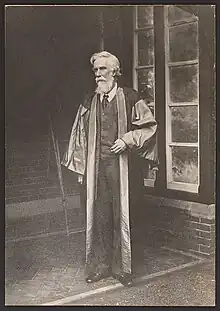A. V. Dicey
Albert Venn Dicey, KC, FBA (4 de febrero de 1835 - 7 de abril de 1922), usualmente citado como A. V. Dicey, fue un jurista y teórico constitucional británico. Es más conocido como el autor de Introduction to the Study of the Law of the Constitution («Introducción al Estudio del Derecho de la Constitución», 1885).[1] Los principios que expone se consideran parte de la constitución británica no codificada. Se convirtió en profesor vineriano de derecho inglés en Oxford y fue uno de los principales eruditos constitucionales de su época. Dicey popularizó la frase "rule of law",[2] aunque su uso se remonta al siglo XVII.
| A. V. Dicey | ||
|---|---|---|
 | ||
| Información personal | ||
| Nombre de nacimiento | Albert Venn Dicey | |
| Nacimiento |
4 de febrero de 1835 Claybrooke Magna (Reino Unido) | |
| Fallecimiento |
7 de abril de 1922 (87 años) Oxford (Reino Unido de Gran Bretaña e Irlanda) | |
| Sepultura | St Sepulchre's Cemetery | |
| Nacionalidad | Británica | |
| Familia | ||
| Padres |
Thomas Edward Dicey Anne Mary Stephen | |
| Cónyuge | Elinor Mary Bonham-Carter | |
| Educación | ||
| Educación | Maestría en Artes, Bachelor of Civil Law y Grado en Artes | |
| Educado en |
| |
| Información profesional | ||
| Ocupación | Consejero legal, profesor universitario, escritor y catedrático | |
| Área | Ciencia del derecho | |
| Cargos ocupados | Juez | |
| Empleador | ||
| Miembro de | ||
| Distinciones |
| |
Biografía
Su padre era Thomas Edward Dicey, senior wrangler (título recibido por la Universidad de Cambridge) en 1811, propietario del Northampton Mercury y presidente de Midland Railway. Su hermano mayor era Edward James Stephen Dicey.[3] También era primo de Leslie Stephen y James Fitzjames Stephen.
Bibliografía
- Introduction to the Study of the Law of the Constitution (8th Edition with new Introduction) (1915)
- A Leap in the Dark, or Our New Constitution (an examination of the leading principles of the Home Rule Bill of 1893) (1893)
- A Treatise on the Rules for the Selection of the Parties to an Action (1870)
- England's Case against Home Rule (1887)
- The Privy Council: The Arnold Prize Essay (1887)
- Letters on unionist delusions (1887)
- A digest of the law of England with reference to the conflict of laws (1st ed. 1896, 2nd ed. 1908);
- later expanded in various editions of Dicey Morris & Collins
- A Fool's Paradise: Being a Constitutionalist's Criticism of the Home Rule Bill of 1912 (1913)
- Lectures on the relation between law and public opinion in England during the nineteenth century (2nd Edition) (1914)
- The Statesmanship of Wordsworth: An Essay. Oxford: Clarendon Press. 1917. Consultado el 7 de abril de 2018 – via Internet Archive.
- Thoughts on the Union between England and Scotland (1920)
- «England in 1848». The Quarterly Review 234: 221-242. October 1920.
- J. W. F. Allison, ed. (2013). The Oxford Edition of Dicey. Oxford: Oxford U.P. ISBN 9780199685820. Vol. 1 includes the first edition of Introduction, with the main addenda in later editions; vol. 2, The Comparative Study of Constitutions, provides largely unpublished lectures on comparative constitutional law, intended for a further book; both volumes have extensive editorial commentary.
Biografías
- Cosgrove, Richard A. (1980). The Rule of Law: Albert Venn Dicey, Victorian jurist. London: Macmillan.
- Ford, Trowbridge H. (1985). Albert Venn Dicey: The Man and His Times. Chichester: Rose.
- Sheppard, Stephen M. (2008). «Dicey, Albert Venn (1835–1922)». En Hamowy, Ronald, ed. The Encyclopedia of Libertarianism. Thousand Oaks, CA: SAGE; Cato Institute. pp. 123-34. ISBN 978-1-4129-6580-4. LCCN 2008009151. OCLC 750831024. doi:10.4135/9781412965811.n77.
Referencias
- Dicey, A. V. (1885). Lectures Introductory to the Study of the Law of the Constitution (1 edición). London: Macmillan. Consultado el 5 de abril de 2018 – via Internet Archive.; Dicey, A. V. (1915). Introduction to the Study of the Law of the Constitution (8 edición). London: Macmillan. Consultado el 5 de abril de 2018 – via Internet Archive. The 8th edition, 1915, is the last by Dicey himself. The final revised edition was the 10th, 1959, edited by E. C. S. Wade: Dicey, A. V. (1959). Introduction to the Study of the Law of the Constitution (10 edición). London: Macmillan.
- Bingham, Thomas. The Rule of Law, p. 3 (Penguin 2010). See Dicey's An Introduction to the Study of the Law of the Constitution, p. 173.
- Neale, Charles Montague (1907). The senior wranglers of the University of Cambridge, from 1748 to 1907. With biographical, & c., notes. Bury St. Edmunds: Groom and Son. p. 28. Consultado el 4 de marzo de 2011.
Enlaces externos
 Wikiquote alberga frases célebres de o sobre A. V. Dicey.
Wikiquote alberga frases célebres de o sobre A. V. Dicey. Wikimedia Commons alberga una categoría multimedia sobre A. V. Dicey.
Wikimedia Commons alberga una categoría multimedia sobre A. V. Dicey. Wikisource en español contiene obras originales de A. V. Dicey.
Wikisource en español contiene obras originales de A. V. Dicey.- Trabajos de o acerca de A. V. Dicey en Internet Archive
- Grave of Albert Venn Dicey and his wife Eleanor in St Sepulchre's Cemetery, Oxford, with biography